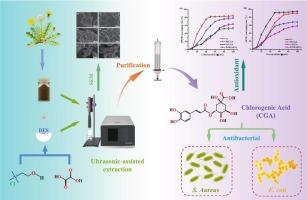Deep eutectic solvent extraction of chlorogenic acid from dandelion with ultrasonic-assisted: Process optimization, purification, and bioactivity
IF 9.7
1区 化学
Q1 ACOUSTICS
引用次数: 0
Abstract
Dandelion, a widely distributed medicinal plant, is rich in chlorogenic acid (CGA). However, research on the extraction and purification of CGA from dandelion, as well as its bioactivity, is insufficient. Therefore, this study developed an efficient and economic method for extracting CGA from dandelions using ultrasonic-assisted deep eutectic solvents. The DES system comprised betaine and oxalic acid, demonstrated high extraction efficiency, and was identified as the optimal extraction solvent. Furthermore, Response Surface Methodology (RSM) was employed to optimize the extraction conditions, which included: water content of 42 %, ultrasonic power of 300 W, ultrasonic temperature of 70 °C, ultrasonic time of 32 min, and solid–liquid ratio of 1:30 g/mL. Under these conditions, the extraction yield of CGA reached 4.27 mg/g. Dandelion samples treated with ultrasound-assisted DES had improved extraction efficiency. Following further purification with macroporous resin, the purified extract of CGA (PECGA) demonstrated significant antioxidant activity. Moreover, this ultrasonic-assisted PECGA showed considerable antibacterial efficacy against Staphylococcus aureus (S. aureus) and Escherichia coli (E. coli). This study provides evidence for potential applications of CGA extracted from dandelions as a natural antioxidant and antibacterial agent in the food and pharmaceutical industries.

超声波辅助深度共晶溶剂萃取蒲公英绿原酸:工艺优化、纯化及生物活性研究。
蒲公英是一种广泛分布的药用植物,富含绿原酸(CGA)。然而,对蒲公英中CGA的提取纯化及其生物活性的研究还不够。因此,本研究开发了一种高效、经济的超声波辅助深共晶溶剂提取蒲公英中CGA的方法。由甜菜碱和草酸组成的DES体系具有较高的萃取效率,并被确定为最佳萃取溶剂。采用响应面法(RSM)优化提取工艺:超声功率300 W,超声温度70℃,超声时间32 min,料液比1:30 g/mL。在此条件下,CGA的提取率达到4.27 mg/g。超声波辅助DES处理蒲公英样品,提高了提取效率。经大孔树脂进一步纯化,纯化后的CGA提取物(PECGA)显示出显著的抗氧化活性。此外,超声辅助PECGA对金黄色葡萄球菌(S. aureus)和大肠杆菌(E. coli)均有较好的抗菌效果。本研究为从蒲公英中提取的CGA作为天然抗氧化剂和抗菌剂在食品和制药工业中的潜在应用提供了依据。
本文章由计算机程序翻译,如有差异,请以英文原文为准。
求助全文
约1分钟内获得全文
求助全文
来源期刊

Ultrasonics Sonochemistry
化学-化学综合
CiteScore
15.80
自引率
11.90%
发文量
361
审稿时长
59 days
期刊介绍:
Ultrasonics Sonochemistry stands as a premier international journal dedicated to the publication of high-quality research articles primarily focusing on chemical reactions and reactors induced by ultrasonic waves, known as sonochemistry. Beyond chemical reactions, the journal also welcomes contributions related to cavitation-induced events and processing, including sonoluminescence, and the transformation of materials on chemical, physical, and biological levels.
Since its inception in 1994, Ultrasonics Sonochemistry has consistently maintained a top ranking in the "Acoustics" category, reflecting its esteemed reputation in the field. The journal publishes exceptional papers covering various areas of ultrasonics and sonochemistry. Its contributions are highly regarded by both academia and industry stakeholders, demonstrating its relevance and impact in advancing research and innovation.
 求助内容:
求助内容: 应助结果提醒方式:
应助结果提醒方式:


